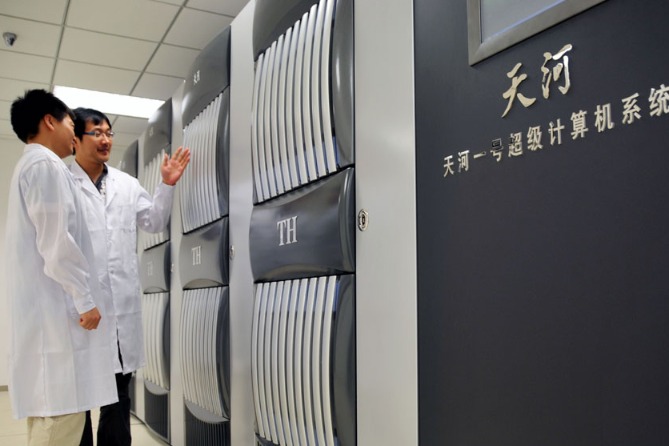Investment, talent, not theft, drive China's R&D

Technology experts check the condition of the Tianhe-1 supercomputer at the National SuperComputer Center in Tianjin.
China has made remarkable breakthroughs in science and technology during the four decades of reform and opening-up. For example, it has achieved progress in the fields of manned spaceship, deep submarine, supercomputers, and quantum communications technology. Besides, it has also enhanced its research capability.
These achievements would not have been possible without the efforts of Chinese scientists and the people's pursuit of happiness. It is therefore absurd for the United States to accuse China of "stealing" technologies and patents from US enterprises and researchers. In fact, it is impossible to imagine that a country with more than 1.3 billion people would depend on some "stolen" technologies for development.
Since 2000, China's investment in research and development has been growing at an average rate of 20 percent a year. Data show that in 2015, China's investment in R&D was the second largest in the world, even though it is still a developing country. China's investment in R&D accounts for 2.12 percent of its GDP, higher than the average 2.08 percent of all European Union member states.
In particular, 77 percent of China's R&D funds come from enterprises, which is higher than that of most developed countries. As many as 130 Chinese enterprises were on the list of 2017 Global Innovation 1000, a ranking list released by PricewaterhouseCoopers, and their total spending on R&D was $46.8 billion. According to the EU, Chinese enterprise Huawei allocated €10.4 billion ($12.1 billion) to R&D last year, the sixth-highest in the world and more than that of Apple Inc.
China also has abundant human resources for R&D in technology. Since 2007, the total number of Chinese people with a bachelor's or higher degree engaged in technology R&D has been the highest in the world. In 2015 alone, 23.4 percent of the world's top degrees in science and engineering came from China.
With heavy investment, China has been making great progress in winning patents. For six successive years, China has been topping the world in the number of patent applications accepted, while its number of effective patents ranked third in the world. In 2017, China submitted 48,882 international Patent Cooperation Treaty applications, the second highest in the world.
From 2006 to 2016, Chinese researchers in technology published 1.74 million essays for international consumption, ranking second in the world. Besides, 12.8 percent of the top 1 percent most frequently quoted essays in the world were written by Chinese researchers, ranking third in the world.
The first reason for these glorious achievements is the internal needs of China. The idea of science, technology and innovation leading a country's economy has been so deeply influencing that Chinese people have given rise to an innovation trend.
And the deepening reform and opening-up have helped to unleash hidden potential. As the new round of science and industrial revolution accelerates, the traditional rules of Western countries have become obstacles to the progress of science. China has overcome those obstacles by deepening supply-side reform and allowing the market to play a decisive role in the allocation of resources, and that's why it has made remarkable breakthroughs and great progress in technology.

